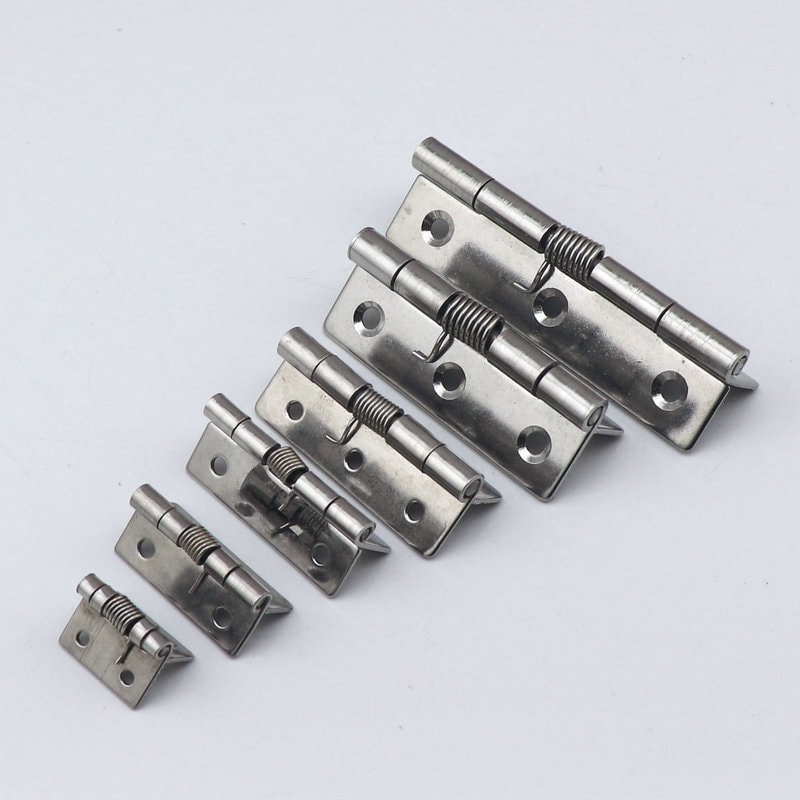In today’s era of specialized applications, ensuring that each component, especially ones as nuanced as spring hinges, is tailored perfectly has become paramount. A slight deviation or oversight can compromise the entire functionality. As such, equipping oneself with the right knowledge becomes instrumental when seeking customization.
To successfully customize a spring hinge, comprehending the vital parameters and effectively conveying this information to the manufacturer is pivotal. This meticulous approach guarantees that the end product will not only adhere to your needs but will also operate at its optimal capacity.
Dive with us into this labyrinth of details, as we unravel and spotlight the essence of each specification required in the customization of spring hinges.
Material Selection
The choice of material often serves as the bedrock for the spring hinge’s durability and efficiency. Each material comes with its unique properties that cater to different demands, such as flexibility, resistance to external elements, and strength. It is paramount to detail the intended working environment of the hinge, enabling the manufacturer to provide guidance on the best-suited material.
Moreover, understanding the pros and cons of each material can also play a pivotal role in this decision. For example, while stainless steel might offer corrosion resistance, brass could be opted for its aesthetic appeal, depending on the hinge’s purpose.

Dimensional Specifications
Accuracy in dimensions is the linchpin for a well-fitted spring hinge. Essential dimensions like length, width, and thickness must be provided. Furthermore, any specific requirements concerning the hinge’s leaf or knuckles should be outlined, ensuring a snug fit in its designated space.
Additionally, the concept of permissible tolerances comes into play here. Specifying acceptable deviations, if any, in these dimensions can offer some flexibility in manufacturing without compromising the hinge’s functionality.
Spring Tension and Load
A spring hinge’s responsiveness hinges (pun intended) on its tension. The intricacies like whether the hinge should snap back with vigor or glide back gently are tied to this detail. Besides, the amount of load the hinge is expected to bear without deforming is essential information.
This load-bearing capacity plays an integral role in ensuring that the hinge doesn’t give way or deform, especially when used in applications where they bear significant weight or undergo frequent use.

Pin Details
At the heart of a spring hinge’s movement lies the pin. This tiny but vital component’s specifications, such as its material, diameter, and any required coatings or treatments, must be stated. These details are crucial in ensuring smooth operations and enhancing the hinge’s lifespan.
Understanding the operational dynamics of the pin, such as its rotational friction and potential wear and tear, can further help in specifying any additional requirements.
Finish and Appearance
Beyond the realm of furniture and architecture, the aesthetic value of a component often holds weight. The desired finish, whether matte, glossy, or a protective layer to shield against environmental hazards, must be conveyed.
The finish not only enhances the visual appeal but often also serves as a protective layer against elements like corrosion, enhancing the hinge’s overall life.
Mounting Method
The manner in which a hinge is mounted can significantly impact its functionality and integration with its intended application. Several factors can dictate the choice of mounting, from the material where the hinge will be affixed to the weight it will bear. Specifying the mounting method, whether it’s screws, rivets, or welding, is pivotal in ensuring the hinge is designed to align seamlessly with its environment.
Moreover, each mounting technique brings with it its unique set of advantages and potential challenges. Screws, for instance, offer easier adjustability and removal, while welding might promise more permanence and strength. It’s essential to evaluate the intended application and operational demands to determine the best-suited mounting method, thereby enabling the manufacturer to create the most compatible hinge design.

Lifespan and Cycle Expectations
Every component in a mechanism has an expected operational life, and the spring hinge is no exception. The hinge’s lifespan can be quantified in terms of cycles – how many times it can open and close without manifesting wear or a decrease in performance. Specifying this information is vital, as it allows manufacturers to opt for materials and design attributes that can withstand the set operational demands.
Beyond just the raw number of cycles, understanding the frequency and intensity of use can provide deeper insights into the hinge’s design needs. For instance, a hinge expected to operate frequently but with light loads might have different design specifications compared to one subjected to heavy loads but lesser frequency. By providing a clear picture of the hinge’s anticipated lifespan and cycle expectations, one ensures longevity and optimal performance.
Special Features or Add-ons
The world of spring hinges isn’t confined to just opening and closing; there exists a plethora of special features and add-ons that can enhance its functionality. These can range from grease fittings that ensure smooth operation to locking mechanisms that provide added security. Highlighting any such requirements is crucial, ensuring the hinge is tailor-made to the user’s specific needs.
In addition, while some add-ons might be essential for certain applications, others might serve to enhance convenience or safety. For instance, a safety catch might be a crucial feature for hinges used in specific industrial settings, while anti-squeak pads could be desired for quieter operations. By laying out any additional features or requirements, one ensures that the customized hinge isn’t just functional but also augmented for enhanced usability.
Conclusion
Customizing a spring hinge requires a clear understanding and communication of various parameters. By providing detailed and accurate information to the manufacturer, you ensure the hinge meets your application’s exact requirements, ensuring optimal performance and longevity.
You might also be interested:
- What are the features of Brass hinges?
- What are traditional hinges?
- What are the Features of Acrylic Hinges?




